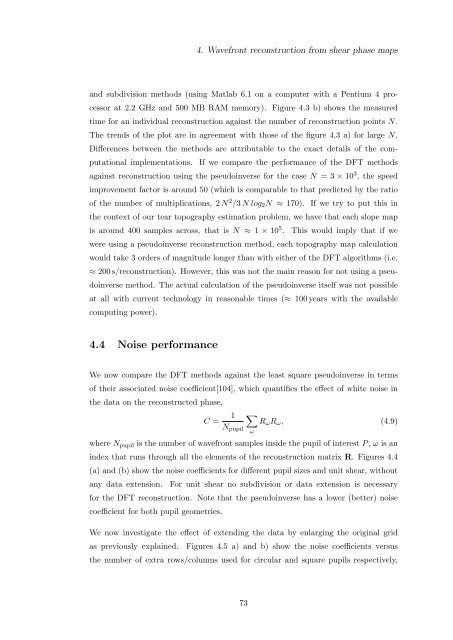Alfredo Dubra's PhD thesis - Imperial College London
Alfredo Dubra's PhD thesis - Imperial College London
Alfredo Dubra's PhD thesis - Imperial College London
You also want an ePaper? Increase the reach of your titles
YUMPU automatically turns print PDFs into web optimized ePapers that Google loves.
4. Wavefront reconstruction from shear phase maps<br />
and subdivision methods (using Matlab 6.1 on a computer with a Pentium 4 processor<br />
at 2.2 GHz and 500 MB RAM memory). Figure 4.3 b) shows the measured<br />
time for an individual reconstruction against the number of reconstruction points N.<br />
The trends of the plot are in agreement with those of the figure 4.3 a) for large N.<br />
Differences between the methods are attributable to the exact details of the computational<br />
implementations. If we compare the performance of the DFT methods<br />
against reconstruction using the pseudoinverse for the case N = 3 × 10 3 , the speed<br />
improvement factor is around 50 (which is comparable to that predicted by the ratio<br />
of the number of multiplications, 2 N 2 /3 N log 2 N ≈ 170). If we try to put this in<br />
the context of our tear topography estimation problem, we have that each slope map<br />
is around 400 samples across, that is N ≈ 1 × 10 5 . This would imply that if we<br />
were using a pseudoinverse reconstruction method, each topography map calculation<br />
would take 3 orders of magnitude longer than with either of the DFT algorithms (i.e.<br />
≈ 200 s/reconstruction). However, this was not the main reason for not using a pseudoinverse<br />
method. The actual calculation of the pseudoinverse itself was not possible<br />
at all with current technology in reasonable times (≈ 100 years with the available<br />
computing power).<br />
4.4 Noise performance<br />
We now compare the DFT methods against the least square pseudoinverse in terms<br />
of their associated noise coefficient[104], which quantifies the effect of white noise in<br />
the data on the reconstructed phase,<br />
C = 1 ∑<br />
R ω R ω , (4.9)<br />
N pupil<br />
where N pupil is the number of wavefront samples inside the pupil of interest P , ω is an<br />
index that runs through all the elements of the reconstruction matrix R. Figures 4.4<br />
(a) and (b) show the noise coefficients for different pupil sizes and unit shear, without<br />
any data extension. For unit shear no subdivision or data extension is necessary<br />
for the DFT reconstruction. Note that the pseudoinverse has a lower (better) noise<br />
coefficient for both pupil geometries.<br />
We now investigate the effect of extending the data by enlarging the original grid<br />
as previously explained. Figures 4.5 a) and b) show the noise coefficients versus<br />
the number of extra rows/columns used for circular and square pupils respectively,<br />
ω<br />
73

















